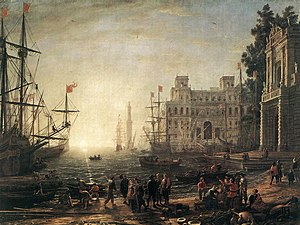Mercantilism
Mercantilism is a kind of economic system that was present in most parts of Europe between the 16th and the 18th century.

The term was first used by Marquis de Mirabeau in 1794. Adam Smith made it known to a wider audience in 1776. At that time, absolutism was the main form of government in Europe. These regimes needed money to finance a large military, the many people who worked in the government. The monarchs and princes also needed money in order to finance their lifestyle. These governments were also very nationalistic. For this reason, mercantilism is seen as a form of economic nationalism.[1]
The theory of mercantilism holds that the prosperity of a nation depends on its supply of capital, and that the global volume of international trade is "unchangeable". Economic assets (or capital) are bullion (gold, silver, and trade value) held by the state, and is best increased through a positive balance of trade with other nations (exports minus imports).
The theory assumes that wealth and monetary assets are identical. Mercantilism suggests that the ruling government should advance these goals by playing a protectionist role in the economy by encouraging exports and discouraging imports, notably through the use of tariffs and subsidies.[2] The theory dominated Western European economic policies from the 16th to the late-18th century.[1]
References change
- ↑ 1.0 1.1 "Mercantilism". The Concise Encyclopedia of Economics. Retrieved 2010-03-14.
- ↑ LaHaye, Laura. "Mercantilism". Library Fund, Inc. Retrieved 2008-10-27.